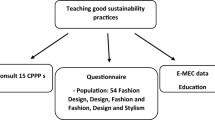Abstract
Art is a tool for education and can facilitate knowledge transfer and sciences to infants and schoolchildren. Therefore, tourism products such as geotourism which are classified as educational tourism can benefit from art and artists for knowledge transfer from the professional level to tourists, locals and children. In this context, this research has three major purposes: (1) to address how activities and strategies in geotourism can be applied for the purpose of geoknowledge transfer and geo-education; (2) to introduce art, especially handicrafts, as an educational tool for promoting geotourism; and (3) to promote geoproducts inspired by the existence of fossils in Isfahan Province, Iran. On the basis of the results of this study, it can be concluded that integrating traditional art with geological elements can be a strategy for geo-education and popularisation of Earth sciences.








Similar content being viewed by others
References
Amrikazemi AR (2013) Geoheritage atlas of Iran. Geological Survey of Iran Publications, Tehran
Benson A (2005) Research tourism: professional travel for useful discoveries. In: Novelli M (ed) Niche tourism: contemporary issues, trends and cases. Elsevier Butterworth-Heinemann, Linacre House, Jordan Hill, Oxford, pp 131–142
Boys B (2012) Sustainable economic development: issue framing and opportunities for the Hondsrug Geopark, Master thesis, University of Groningen (Netherlands) and University of Illinois Urbana Champaign (USA)
Canadian Tourism Commission (CTC) (ed) (2001) Learning travel: ‘Canadian Ed Ventures’ learning vacations in Canada: an overview, Canadian Tourism Commission, Ontario, Canada
Compľová M (2010) The identification of geoproducts in the village of Jakubany as a basis for geotourism development. Acta Geoturistica 1(1):51–56
DiSano J (1995) “Indicators of sustainable development: guidelines and methodology”. United Nations Division for Sustainable Development, pp.33, Available at http://www.un.org/esa/sustdev/publications /indisd-mg2001.pdf (accessed 10 Jan. 2010)
Eder F, Patzak M (2004) Geoparks—geological attractions: a tool for public education, recreation and sustainable economic development. UNESCO, Division of Earth Sciences, Paris, pp 162–164
Farsani NT, Coelho C, Costa C (2011) Geotourism and geoparks as novel strategies for socio-economic development in rural areas. Int J Tour Res 13(1):68–81
Farsani NT, Coelho C, Costa C, Neto de Carvalho C (2012) Geoparks and geotourism: new approaches to sustainability for the 21st century. BrownWalker Press Publisher, Florida
Farsani NT, Coelho C, Costa C, Amrikazemi A (2014) Geo-knowledge management and geoconservation via geoparks and geotourism. Geoheritage Journal 2014(6):185–192Springer
Farsani NT, Mortazavi M, Shafiei Z, Kalantary R, Bahrami A (2016) Creative city and new orientations in handicrafts (Case study: Isfahan, Iran) . Presented in The 1st Trilateral International Conference, 10 May, Isfahan, Iran
Frey ML, Schäefer K, Büchel G, Patzak M (2006) Geoparks—a regional, European and global policy. In: Dowling R, Newsome D (eds) Geotourism, sustainability, impacts and management. Elsevier, Butterworth Heinemann, Oxford, pp 96–117
Geraldes J, Ferreira R (2009) Tourism: “tectonics” and geo-bakery. In: Neto de Carvalho C, Rodrigues J (ed) Proceedings of 8th European Geoparks Conference, 14–16 September, Idanha-a-Nova, Castelo Branco, pp 100–103.
IRNA (Islamic Republic News Agency) (2015) Isfahan named creative city by UNESCO Available at: http://www.irna.ir/en/News/81877447/ (accessed: 24 Dec. 2015)
Janssen AW, Jagt JWM, Yazdi M, Bahrami A, Sadri S (2013) Early-middle Eocene faunal assemblages from the Soh area, north-central Iran, 1. Introduction and pteropods (Mollusca, Gastropoda, Thecosomata). Cainozoic Research 10(1–2):23–34
Lima EA, Machado M, Nunes JC (2013) Geotourism development in the Azores archipelago (Portugal) as an environmental awareness tool. Czech Journal of Tourism 2(2):126–142
Mazumdar MK (2007) The ‘geopark’ initiative. Curr Sci, 92(1):1–12
Mieczkowski Z (ed) (1995) Environmental issues of tourism and recreation. University Press of America, New York
Morais PAM (2015) Good practice cases in sustainable tourism destinations geotouris development, the Azores (Portugal) Available at: http://www.qualitycoast.info/wp-content/uploads/2013/08/pt-lagos -business-involvement.pdf (accessed: 23 Dec. 2015)
Newsome D, Dowling R (2010) Setting an agenda for geotourism. In: Newsome D, Dowling R (eds) Geotourism: the tourism of geology and landscape. Goodfellow Publishers, Oxford, pp 4–8
Ngwira PM (2015) Geotourism and geoparks: Africa’s current prospects for sustainable rural development and poverty alleviation. In Errami E, Brocx M, Semeniuk V (eds) From Geoheritage to geoparks, geoheritage, geoparks and geotourism. Springer International Publishing, Cham
Nonaka I (1991) The knowledge creating company. Harv Bus Rev 69(6):96–104
Oxford dictionary (2015) Art. Available at: https://en.oxforddictionaries.com/definition/art (accessed: 2 February 2015).
Ritchie BW, Carr N, Cooper C (ed) (2003) Managing educational tourism, an imprint of multilingual matters Ltd: Channel View Publications, Bristol
Rodrigues JC, Neto de Carvalho C (2009) Geoproducts in geopark Naturtejo, Proceedings of 8th European Geoparks Conference, Idanha-a-Nova, Portugal, pp. 82–86, 14–16 Sept.
Sandelowski M (1995) Sample size in qualitative research. Research in Nursing & Health 18(2):179–183
Smith R (ed) (1982) Learning how to learn. Follett, Chicago
Smith C, Jenner P (1997) Market segments: educational tourism. Travel and Tourism Analyst 3:60–75
UNESCO (1999) UNESCO geoparks programme—a new initiative to promote a global network of geoparks safeguarding and developing selected areas having significant geological features. 156 EX/11 Rev. PARIS, 15 April 1999. Available at: http://unesdoc.unesco.org/images/0011/001151/115177e.pdf (Site accessed: 15 March 2011)
UNESCO Global Geoparks Network Guidelines (2010) Guidelines and criteria for national geoparks seeking UNESCO’s assistance to join the Global Geoparks Network (GGN) (April 2010), http://www.unesco.org/science/earth/doc/geopark/2010guidelines.pdf. Accessed 24 Oct. 2010
Wulff HE (1966) Traditional crafts of Persia: their development, technology and influence on eastern and western civilizations. The MIT Press, USA
Xun Z, Milly W (2002) National geoparks initiated in China: putting geoscience in the service of society. Episodes 25(1):33–37
Yazdi M, Bahrami A, Vega FJ (2009) Albian decapod Crustacea from Southeast Isfahan. Central Iran-Kolah-Qazi area Bulletin of the Mizunami Fossil Museum 35:71–77
Yazdi M, Bahrami A, Leloux J (2011) Funginella? isfahanensis n. sp. from the upper Albian of Iran. Revista Mexicana de Ciencias Geológicas 28(2):226–234
Author information
Authors and Affiliations
Corresponding author
Rights and permissions
About this article
Cite this article
Farsani, N.T., Mortazavi, M., Bahrami, A. et al. Traditional Crafts: a Tool for Geo-education in Geotourism. Geoheritage 9, 577–584 (2017). https://doi.org/10.1007/s12371-016-0211-2
Received:
Accepted:
Published:
Issue Date:
DOI: https://doi.org/10.1007/s12371-016-0211-2




